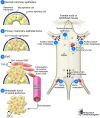Defining a role for the homeoprotein Six1 in EMT and mammary tumorigenesis
- PMID: 19726879
- PMCID: PMC2735897
- DOI: 10.1172/JCI40555
Defining a role for the homeoprotein Six1 in EMT and mammary tumorigenesis
Abstract
Homeobox (Hox) genes encode transcription factors that act as critical regulators of growth and differentiation during embryogenesis. While many studies have identified increased expression of Hox genes in tumors, much less is known about the mechanistic basis by which Hox genes facilitate tumor development. In this issue of the JCI, McCoy and colleagues show that transgenic mice that express the homeoprotein Six1 in mammary epithelial cells show increases in stem/progenitor cell populations and subsequent tumor development, while in a separate study Micalizzi and colleagues show that overexpression of Six1 facilitates breast cancer cell metastasis by inducing epithelial-mesenchymal transition (EMT) (see the related articles beginning on pages 2663 and 2678, respectively). Their findings implicate Six1 as a central mediator of breast cancer development.
Figures

Comment on
-
Six1 expands the mouse mammary epithelial stem/progenitor cell pool and induces mammary tumors that undergo epithelial-mesenchymal transition.J Clin Invest. 2009 Sep;119(9):2663-77. doi: 10.1172/JCI37691. Epub 2009 Aug 24. J Clin Invest. 2009. PMID: 19726883 Free PMC article.
-
The Six1 homeoprotein induces human mammary carcinoma cells to undergo epithelial-mesenchymal transition and metastasis in mice through increasing TGF-beta signaling.J Clin Invest. 2009 Sep;119(9):2678-90. doi: 10.1172/JCI37815. Epub 2009 Aug 24. J Clin Invest. 2009. PMID: 19726885 Free PMC article.
References
Publication types
MeSH terms
Substances
Grants and funding
LinkOut - more resources
Full Text Sources
Research Materials

